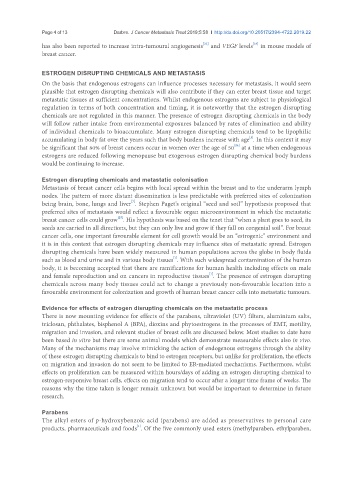Page 391 - Read Online
P. 391
Page 4 of 13 Darbre. J Cancer Metastasis Treat 2019;5:58 I http://dx.doi.org/10.20517/2394-4722.2019.22
[22]
[23]
has also been reported to increase intra-tumoural angiogenesis and VEGF levels in mouse models of
breast cancer.
ESTROGEN DISRUPTING CHEMICALS AND METASTASIS
On the basis that endogenous estrogens can influence processes necessary for metastasis, it would seem
plausible that estrogen disrupting chemicals will also contribute if they can enter breast tissue and target
metastatic tissues at sufficient concentrations. Whilst endogenous estrogens are subject to physiological
regulation in terms of both concentration and timing, it is noteworthy that the estrogen disrupting
chemicals are not regulated in this manner. The presence of estrogen disrupting chemicals in the body
will follow rather intake from environmental exposures balanced by rates of elimination and ability
of individual chemicals to bioaccumulate. Many estrogen disrupting chemicals tend to be lipophilic
[1]
accumulating in body fat over the years such that body burdens increase with age . In this context it may
[24]
be significant that 80% of breast cancers occur in women over the age of 50 at a time when endogenous
estrogens are reduced following menopause but exogenous estrogen disrupting chemical body burdens
would be continuing to increase.
Estrogen disrupting chemicals and metastatic colonisation
Metastasis of breast cancer cells begins with local spread within the breast and to the underarm lymph
nodes. The pattern of more distant dissemination is less predictable with preferred sites of colonization
being brain, bone, lungs and liver . Stephen Paget’s original “seed and soil” hypothesis proposed that
[7]
preferred sites of metastasis would reflect a favourable organ microenvironment in which the metastatic
breast cancer cells could grow . His hypothesis was based on the tenet that “when a plant goes to seed, its
[25]
seeds are carried in all directions, but they can only live and grow if they fall on congenial soil”. For breast
cancer cells, one important favourable element for cell growth would be an “estrogenic” environment and
it is in this context that estrogen disrupting chemicals may influence sites of metastatic spread. Estrogen
disrupting chemicals have been widely measured in human populations across the globe in body fluids
[1]
such as blood and urine and in various body tissues . With such widespread contamination of the human
body, it is becoming accepted that there are ramifications for human health including effects on male
[1]
and female reproduction and on cancers in reproductive tissues . The presence of estrogen disrupting
chemicals across many body tissues could act to change a previously non-favourable location into a
favourable environment for colonization and growth of human breast cancer cells into metastatic tumours.
Evidence for effects of estrogen disrupting chemicals on the metastatic process
There is now mounting evidence for effects of the parabens, ultraviolet (UV) filters, aluminium salts,
triclosan, phthalates, bisphenol A (BPA), dioxins and phytoestrogens in the processes of EMT, motility,
migration and invasion, and relevant studies of breast cells are discussed below. Most studies to date have
been based in vitro but there are some animal models which demonstrate measurable effects also in vivo.
Many of the mechanisms may involve mimicking the action of endogenous estrogens through the ability
of these estrogen disrupting chemicals to bind to estrogen receptors, but unlike for proliferation, the effects
on migration and invasion do not seem to be limited to ER-mediated mechanisms. Furthermore, whilst
effects on proliferation can be measured within hours/days of adding an estrogen disrupting chemical to
estrogen-responsive breast cells, effects on migration tend to occur after a longer time frame of weeks. The
reasons why the time taken is longer remain unknown but would be important to determine in future
research.
Parabens
The alkyl esters of p-hydroxybenzoic acid (parabens) are added as preservatives to personal care
products, pharmaceuticals and foods . Of the five commonly used esters (methylparaben, ethylparaben,
[1]

